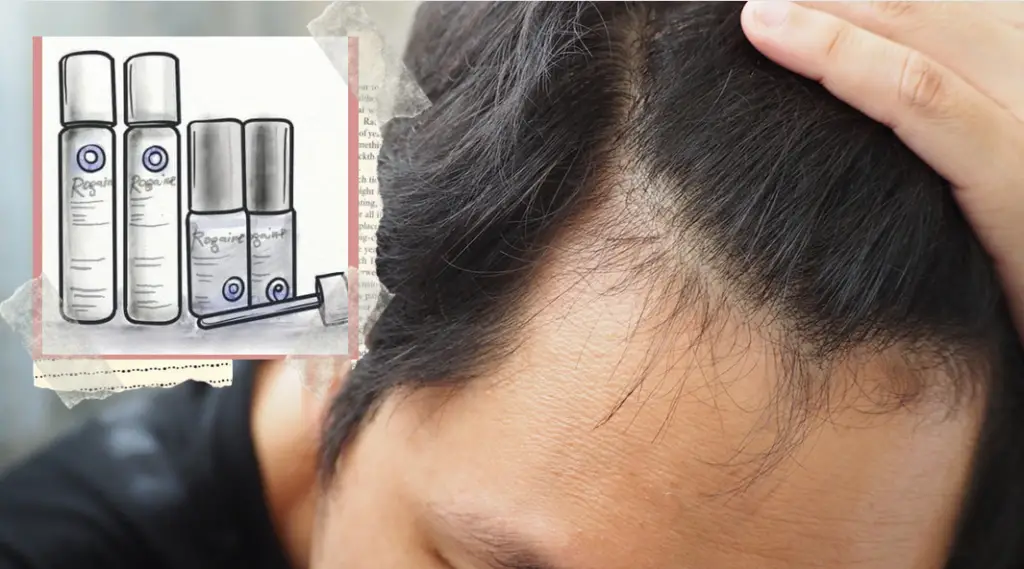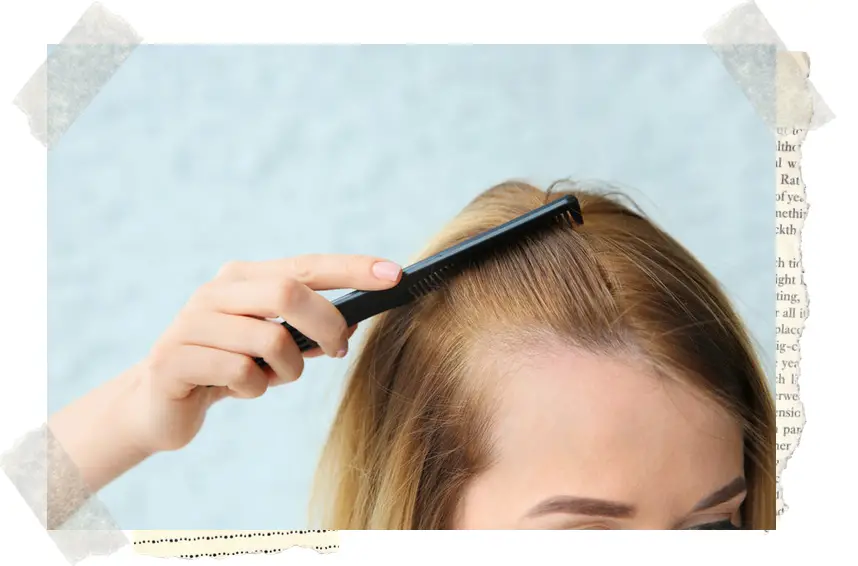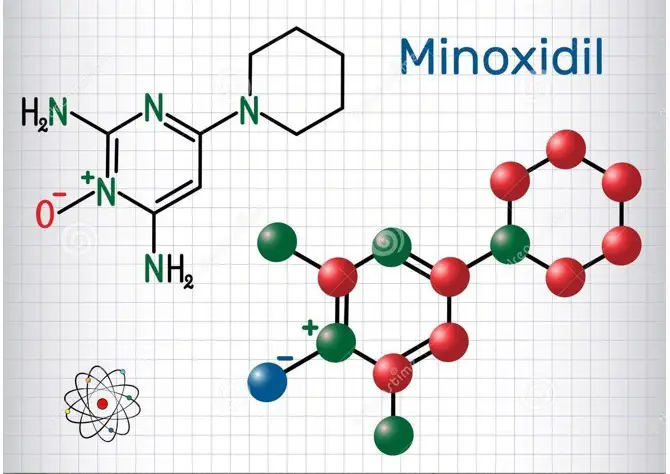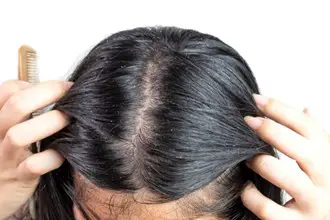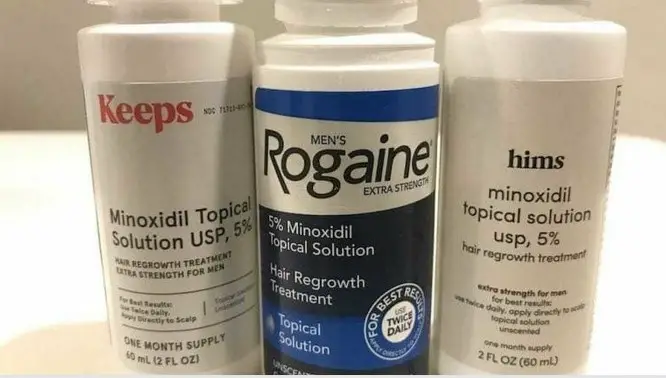A receding hairline can be a cause of concern for many, prompting the search for an effective solution. Minoxidil has emerged as a popular option to address this issue by promoting hair regrowth and improving hair density.
In this blog post, we will dive into the world of minoxidil, examining its history, mechanisms, potential side effects, and success rates. By providing clear explanations and actionable advice supported by research studies and real-life experiences, we aim to help you make informed decisions on whether minoxidil is right for your receding hairline. So let’s get started with discovering how minoxidil can transform your crowning glory!
Understanding Minoxidil For Receding Hairlines
Minoxidil is a medication that can help with hair regrowth and has been used for decades. It works by increasing blood flow to the hair follicles in the treated area, which boosts growth rate and hair density over time.

The History Of Minoxidil
The history of Minoxidil begins in the late 1950s, when it was initially developed as a medication for treating high blood pressure. Scientists at Upjohn Corporation discovered that this powerful vasodilator had an intriguing side effect – many patients experienced significant hair growth while taking the drug. By the 1980s, researchers recognized its potential as an effective treatment for hair loss and began conducting clinical trials to further understand its benefits.
In 1988, after extensive testing and research, the U.S. Food and Drug Administration (FDA) approved Minoxidil under the brand name Rogaine as a topical solution for combating and reverse male pattern baldness. This marked a significant milestone in hair restoration treatments, making it the first FDA-approved option on the market. As studies continued throughout subsequent years, Minoxidil gained approval to treat female pattern hair loss in addition to other types of alopecia such as androgenetic alopecia – now known to be one of its most successful applications. Today, Minoxidil remains a popular choice among individuals seeking solutions for various forms of hair loss based on decades of proven effectiveness backed by scientific research.
How It Works On Hair Follicles
Minoxidil, a topical solution for hair loss, works directly on the hair follicles to stimulate growth and improve hair density. Its active ingredient enhances blood flow in the scalp region where it is applied, providing essential nutrients and oxygen to the follicles. This increased circulation encourages an extended anagen (growth) phase of the hair growth cycle, resulting in thicker strands and a higher rate of overall growth.
For those dealing with receding hairlines or thinning at the temples, Minoxidil can be especially effective by targeting these affected areas. Studies have shown that both men and women with male pattern baldness or female pattern baldness benefit from using Minoxidil as part of their daily routine. Additionally, individuals experiencing alopecia areata or androgenetic alopecia find success with this treatment option as well.
Consistency is key when applying Minoxidil to achieve desired results in combating frontal hair loss or regrowing lost locks. It’s essential for users to follow proper application techniques and maintain regular use over time to maximize its effectiveness on their specific hair concerns – whether fighting a receding hairline, temple thinning or bald spots throughout the scalp.
Potential Side Effects
Minoxidil for receding hairline can have potential side effects. It’s important to consult with a physician before starting to use minoxidil as a hair loss treatment, and to be aware of the possible risks associated with using it. Here are some potential side effects of minoxidil:
1. Scalp Irritation: Minoxidil can cause scalp irritation, including redness, itching, burning and flaking.
2. Increased Heart Rate: In rare cases, minoxidil can cause an increased heart rate which may lead to chest pain or discomfort.
3. Unwanted Hair Growth: Minoxidil may promote unwanted hair growth in areas such as the face or hands.
4. Sexual Side Effects: Some men may experience sexual side effects while using minoxidil, such as decreased libido or erectile dysfunction.
5. Cancer Risks: There is some evidence linking long-term use of topical minoxidil with an increased risk of cancer.
It’s important to monitor any potential side effects while using minoxidil and seek medical attention if necessary.
Success Rates For Regrowth
Minoxidil has been proven to be effective in promoting hair regrowth in many cases, but the success rates for regrowth can vary widely depending on individual factors. According to research, those with a receding hairline may see some improvement with minoxidil use, but it’s important to have realistic expectations. It is also important to note that success rates may be higher for those using stronger concentrations of minoxidil and for those who are consistent with their application techniques.
Studies have shown that about 40% of people using minoxidil experience moderate-to-marked hair regrowth after four months of use. However, it is important to remember that not everyone will see the same results and some people may need longer treatment periods for desired outcomes. Additionally, other approaches such as lifestyle changes and professional interventions should also be considered when addressing hair loss concerns along with the use of minoxidil.
Does Minoxidil Work On A Receding Hairline?
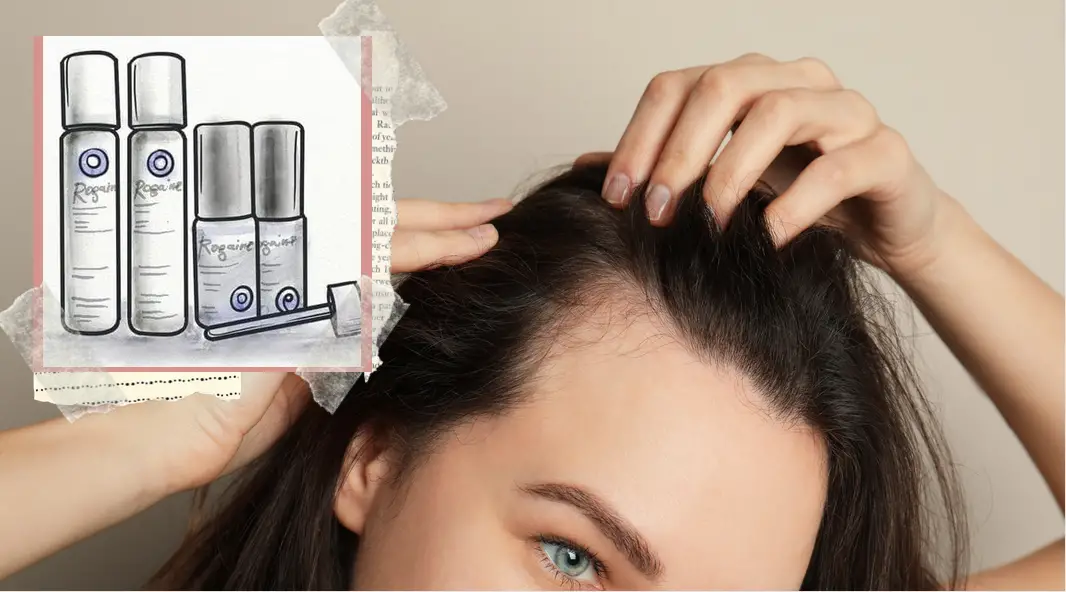
Research and studies have shown that minoxidil can be effective in promoting hair growth on a receding hairline, but success rates depend on various factors. Keep reading to learn more about the realistic expectations and how to maximize the effectiveness of this treatment.
Research And Studies
Minoxidil has been extensively researched and studied to understand its effectiveness in treating receding hairlines. Various studies have been conducted on its efficacy, safety, and potential side effects. Below is a summary of some key research findings:
| Study | Findings |
|---|---|
| 2019 systematic review and meta-analysis | Topical minoxidil was found to be effective in promoting hair growth for both men and women with androgenetic alopecia. The review also found that minoxidil was well-tolerated with minimal side effects. |
| 2004 randomized, double-blind study | This study found that 5% minoxidil was more effective than 2% minoxidil and placebo in promoting hair regrowth in men with androgenetic alopecia. |
| 2014 comparative study | The study concluded that minoxidil is effective in treating receding hairlines, but its efficacy may vary depending on the individual and the severity of hair loss. |
| 2011 study on the efficacy of 3% minoxidil lotion | This study reported a significant increase in hair density and overall improvement in hair appearance among participants who used 3% minoxidil lotion for 24 weeks. |
These studies indicate that minoxidil can be effective in treating receding hairlines, but individual results may vary. It’s important to have realistic expectations and consult with a healthcare professional to determine if minoxidil is the right treatment for your specific situation.
Factors That Affect Results
Several factors can affect the effectiveness of minoxidil for receding hairlines, including:
1. Severity of Hair Loss: Minoxidil is more effective on thinning hair compared to bald spots or areas with no hair growth.
2. Age: Younger individuals tend to have better success rates with minoxidil than older individuals due to better blood circulation and responsiveness of hair follicles.
3. Gender: Studies have found that men tend to have better results with minoxidil than women for receding hairlines.
4. Genetics: The extent and pattern of hair loss can be influenced by genetics, which can affect the effectiveness of minoxidil.
5. Compliance: Consistency in using the product as directed is crucial for achieving optimal results. Irregular use can hinder or delay progress.
6. Dosage and Application Method: The concentration and frequency of use can vary depending on individual needs, and improper application techniques may impact efficacy.
7. Underlying Health Conditions: Individuals with underlying health conditions, such as thyroid disorders or autoimmune diseases, may not respond well to minoxidil treatment.
Understanding these factors can help set realistic expectations and optimize the use of minoxidil for regrowing a receding hairline.
Realistic Expectations
It’s important to have realistic expectations when using minoxidil for a receding hairline. While there is evidence that it can help to stop or slow down the process of hair loss, it may not work for everyone. In fact, success rates vary greatly depending on factors such as age, genetics, and the severity of the hair loss.
It’s also important to note that minoxidil isn’t a guaranteed solution for complete regrowth of lost hair. It can take several months before any visible results are seen, and even then the amount of regrowth may be limited. However, with consistency in use and proper application techniques, you may experience some improvement in your hairline over time.
Lastly, it’s worth bearing in mind that combining minoxidil use with other approaches can increase its effectiveness. This could include lifestyle modifications like eating a nutrient-rich diet or taking additional supplements known to promote healthy hair growth; or professional interventions such as laser therapy or scalp micropigmentation. By managing your expectations realistically and adopting a comprehensive approach to addressing your receding hairline concerns; you’ll be better equipped to enjoy improved results over time while minimizing potential disappointments along the way.
Minoxidil Before And After Hairline
One of the most frequently asked questions about minoxidil is whether it can effectively treat a receding hairline. There are many examples of users who have achieved impressive results with minoxidil, as seen in their “before and after” photos. It’s important to keep in mind that individual results may vary, depending on factors like genetics, age, and overall health. However, many people have reported a noticeable improvement in hair density and regrowth when using minoxidil consistently.
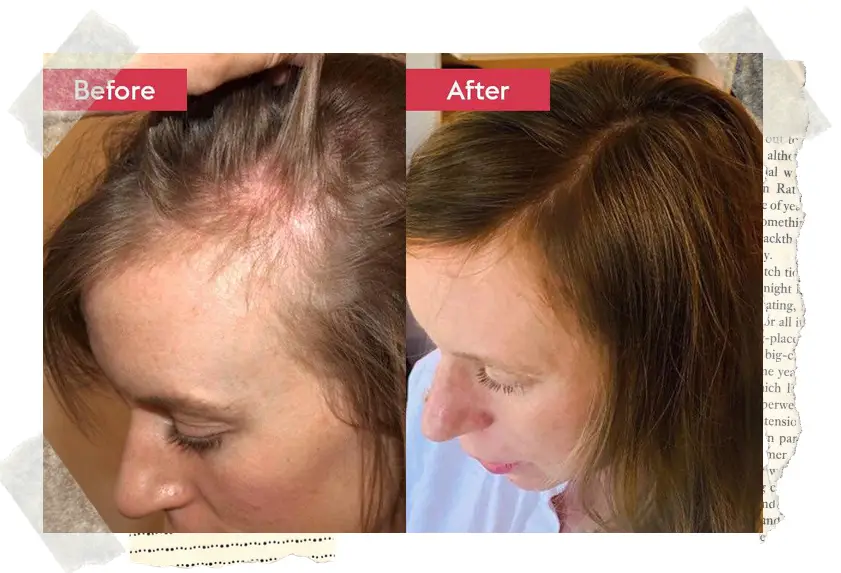
To see optimal results from minoxidil use for a receding hairline, it’s essential to be patient and consistent with application. Minoxidil must be applied directly to the affected area twice daily for at least four months before significant changes are visible. Also, choosing the right concentration that suits your scalp type and following proper application techniques will enhance its effectiveness significantly. Keep in mind; there may still be limitations or potential side effects to consider before starting any new treatment regimen.
Maximizing The Effectiveness Of Minoxidil
To maximize the effectiveness of Minoxidil for a receding hairline, it’s important to choose the right concentration, apply it properly and consistently, and consider combining it with other approaches such as lifestyle modifications or professional interventions.
Choosing The Right Concentration
One of the most important factors in using minoxidil for a receding hairline is choosing the right concentration. There are two concentrations available: Minoxidil 2% foam and 5%. Research has shown that 5% minoxidil is more effective than 2%, particularly for treating alopecia. However, using Minoxidil 15, it’s essential to note that higher concentrations may result in an increased risk of side effects.
It’s crucial to consider your individual needs when choosing a concentration. If you have sensitive skin, starting with a lower concentration may be wise. On the other hand, if you’ve been using minoxidil for some time without seeing results, increasing to the higher percentage might be necessary. It’s also essential to remember that everyone responds differently to medications and treatments; what works for one person may not work for another.
Ultimately, finding the right balance between effectiveness and safety is key when selecting a concentration of minoxidil for treating receding hairlines. Consulting with a medical professional or dermatologist can provide valuable insight into what dosage will work best for you while minimizing potential risks and maximizing benefits from treatment.
Proper Application Techniques
To maximize the effectiveness of minoxidil for a receding hairline, it is important to apply the solution properly. Here are some tips on how to do it correctly:
1. Wash your scalp thoroughly with a mild shampoo and towel dry before applying minoxidil.
2. Part your hair in the area where you will be applying the solution.
3. Using the dropper provided, apply the recommended amount of minoxidil to your scalp.
4. Gently massage the solution into your scalp using your fingertips.
5. Allow the solution to dry completely before styling your hair or going to bed.
6. Wash your hands thoroughly after application.
Remember that consistency is key when using minoxidil, so aim to apply it twice daily as directed by your healthcare provider. Avoid blow-drying or using other styling products immediately after application, as this may reduce its effectiveness.
Consistency In Use
To maximize the effectiveness of minoxidil for a receding hairline, consistency in use is key. Regularly applying minoxidil as directed can help promote hair growth and slow down further hair loss. Experts recommend using it twice daily at the same time each day to maintain consistent levels of the medication on the scalp.
Additionally, proper application techniques are essential for achieving optimal results with minoxidil. Users should apply it directly to their scalp rather than just rubbing it into their hair. They should also use enough product to cover the affected areas thoroughly but not so much that it drips onto other parts of their skin or clothing.
Finally, while patience is necessary when using minoxidil, users should not skip applications or stop using it entirely if they do not see immediate results. It may take up to 6 months or longer before significant regrowth occurs, and consistent use during this time is crucial for success.
Combining Minoxidil With Other Approaches
To maximize the effectiveness of minoxidil for a receding hairline, combining it with other hair care approaches such as lifestyle modifications, additional medications or supplements and professional interventions is recommended.
Lifestyle Modifications For Hair Care
Maintaining a healthy lifestyle is essential in promoting overall hair health and reducing the risk of hair loss. Here are some lifestyle modifications that can help:
1. Eat a balanced diet rich in vitamins and minerals such as iron, zinc, and biotin.
2. Avoid smoking and excessive alcohol consumption.
3. Get regular exercise to improve blood circulation and reduce stress levels.
4. Get enough sleep to allow your body to repair and rejuvenate itself.
5. Be gentle with your hair; avoid harsh treatments such as blow-drying, straightening, or coloring too frequently.
6. Protect your hair from sun damage by wearing a hat or using a protective spray before exposure to the sun.
By incorporating these lifestyle modifications into your daily routine, you can help promote healthy hair growth and reduce the risk of further hair loss. Remember that maintaining a healthy scalp is just as important as taking care of the rest of your body!
Additional Medications Or Supplements
In addition to using minoxidil for receding hairlines, there are other medications and supplements that can help promote hair growth. Finasteride is a prescription medication that inhibits the production of dihydrotestosterone (DHT), which contributes to male pattern baldness. Saw palmetto is a natural supplement that also blocks DHT and may be effective in promoting hair growth.
Biotin is a vitamin that has been shown to improve keratin infrastructure and stimulate hair follicles, leading to thicker and stronger hair. Iron supplements may also be beneficial for those who suffer from iron-deficiency anemia, as this condition can contribute to thinning or brittle hair.
It’s important to note that while these additional medications or supplements may provide benefits for some individuals, they should only be used under the guidance of a healthcare professional. Additionally, effectiveness may vary depending on individual factors such as age, genetics, underlying health conditions, and lifestyle habits like diet and exercise.
Professional Interventions
Professional interventions can be an effective way to combat receding hairline. Hair transplant surgery is one such intervention where healthy hair follicles from other parts of the scalp are transplanted to the balding area. This procedure is best suited for people with significant hair loss and works well if done by a skilled surgeon.
Scalp micropigmentation is another professional intervention that mimics the appearance of a shaved head or short hairs on the scalp, which creates an illusion of fuller coverage in thinner areas. It uses tiny dots or lines with pigment to replicate hair follicles on the scalp.
In general, it’s essential to do thorough research before considering any professional intervention as they carry risks and may not be suitable for everyone. However, when done correctly, they can offer long-lasting results for a more confident look.
Understanding Rogaine Vs Minoxidil
Rogaine and Minoxidil are often used interchangeably, but they are different brands of the same active ingredient: minoxidil.
Differences And Similarities
Differences and similarities between Rogaine and Minoxidil are often a point of discussion among those considering hair regrowth treatments. These key aspects help in understanding which option might be better suited for addressing receding hairlines.
| Rogaine | Minoxidil |
|---|---|
| Brand-name product | Generic form of the active ingredient |
| May come with additional ingredients for improved effectiveness | May not include additional ingredients, primarily offering the active Minoxidil |
| Potentially higher price due to brand recognition | Often more affordable as it is a generic option |
| Men’s and Women’s Rogaine have different Minoxidil concentrations | Generic Minoxidil products may have varying concentrations with or without gender-specific formulations |
| Requires continued use to maintain hair regrowth | Also requires continued use to maintain hair regrowth |
| Side effects can include scalp irritation and increased facial hair growth | Shares the same side effects as Rogaine, including scalp irritation and increased facial hair growth |
Which One Is Better For Receding Hairlines?
When it comes to treating receding hairlines in female and male, both Rogaine and Minoxidil can be effective options. In fact, they are essentially the same thing, with Rogaine being a brand name for the Minoxidil drug. The difference between the two is that Rogaine often includes additional ingredients to help improve absorption into the scalp. However, in terms of effectiveness for hair regrowth, there isn’t any significant difference.
It’s important to note that while these products can aid in promoting hair growth, they may not work for everyone or produce immediate results. Factors such as age, genetics, and underlying health conditions can all play a role in how well these treatments work. Additionally, consistency and adherence to proper application techniques are crucial factors in maximizing their effectiveness.
Ultimately when choosing between Rogaine vs. Minoxidil for receding hairlines or any other form of hair loss treatment approach one should consult with a qualified dermatologist or healthcare professional who has experience dealing with similar cases before making any decisions about which option might be best suited to your unique circumstances.
How Does Minoxidil Work For Early Male Pattern Baldness?
Minoxidil has been found to be effective in promoting hair growth for early male pattern baldness, but understanding the causes and symptoms of this type of hair loss is crucial in determining the success rate. Curious to know more? Keep reading!
Minoxidil For Type Of Hair Loss
Minoxidil can be used for various types of hair loss, including:
1. Androgenetic alopecia: This is the most common type of hair loss in men and women caused by genetics and hormones.
2. Alopecia areata: This is an autoimmune disorder that causes hair loss on the scalp and other areas of the body.
3. Telogen effluvium: This is a condition where significant amounts of hair enter into a resting phase and fall out after a few months due to stress or hormonal changes.
4. Traction alopecia: This is caused by hairstyles that pull on the hair follicles, such as tight braids, buns, or weaves.
5. Frontal fibrosing alopecia: This is a rare condition that causes hair loss at the front of the scalp along with inflammation and scarring.
6. Chemotherapy-induced hair loss: Minoxidil can be used to regrow hair that falls out due to chemotherapy treatment for cancer.
Causes And Symptoms Of Early Baldness
Early baldness is typically caused by a combination of genetic and hormonal factors. Male pattern baldness, the most common form of early baldness, is thought to be hereditary and related to male sex hormones called androgens. These hormones can cause hair follicles to shrink over time, leading to thinner or shorter hairs that eventually stop growing altogether.
Symptoms of early baldness often start with a receding hairline or thinning on the crown of the head. In some cases, hair loss may progress to complete or near-complete balding in those areas. Men are more likely than women to experience early baldness, but it can affect both genders at any age. It’s important for anyone experiencing unexpected hair loss or changes in their hairline to consult with a healthcare professional for diagnosis and treatment options.
Success Rates For Minoxidil Use
Studies have shown that minoxidil can be effective in treating male-pattern hair loss for a majority of patients. In fact, research suggests that around 80% of men who use minoxidil experience some degree of hair regrowth. However, the success rate may vary depending on various factors such as age, extent of baldness, and consistency in using the treatment.
It’s worth noting that minoxidil is not a miracle cure for hair loss and results may not appear overnight. For best outcomes with minoxidil, consistent usage is key – most users will need to apply it twice daily over several months before seeing noticeable changes in their hair growth pattern. Additionally, hair regrowth stimulated by Minoxidil cannot reverse severe or long-standing baldness and other interventions like transplant surgery might be required for severe cases.
Addressing Concerns And FAQs
Get answers to common questions about minoxidil use, such as whether it can make the hairline worse or if it can be used with other hair loss treatments. Don’t let concerns hold you back – read on for expert advice and guidance.
Can Minoxidil Make The Hairline Worse?
One of the most common concerns among individuals using minoxidil for a receding hairline is whether it can make things worse. While there have been reports of increased shedding during early stages of treatment, this is typically due to the medication’s mechanism of action in stimulating dormant hair follicles from their resting phase into an active growth cycle. This shedding is temporary and should subside as new hairs begin to grow.
However, if you notice a significant increase in hair loss or thinning after starting minoxidil treatment, it may be a sign that the medication isn’t working for you or that your underlying condition has worsened. In these cases, it’s best to consult with a dermatologist who can evaluate your scalp and recommend alternative treatments based on your specific needs.
Can Minoxidil And Finasteride Be Used Together?
Combining minoxidil and finasteride can be an effective way to treat hair loss, but it’s important to discuss this option with a healthcare provider. Finasteride is a prescription medication taken orally that works by blocking the hormone DHT, which contributes to hair loss. Minoxidil, on the other hand, is a topical treatment that promotes blood flow and helps increase hair growth. By using both medications together, individuals may see better results than when using them individually.
Research shows that combining topical minoxidil and finasteride can offer significant benefits for treating male pattern baldness. Studies have also shown that higher concentrations of minoxidil produce better results in combination with finasteride than when used alone. However, it’s crucial to follow proper application techniques and use these medications consistently over time for optimal results without any possible side effects such as scalp irritation or increased heart rate.
How To Apply Minoxidil For Receding Hairline?
Applying minoxidil for receding hairline is simple and straightforward. Here’s how to do it:
1. Wash your scalp thoroughly before applying minoxidil.
2. Make sure your hair and scalp are completely dry.
3. Using the dropper provided, apply the solution directly to the affected area on your scalp.
4. Massage the solution gently into your scalp using your fingers.
5. Allow the solution to dry completely before styling or going to bed.
It is recommended to apply minoxidil twice a day, once in the morning and once at night, for maximum effectiveness. It is important to avoid getting the solution in your eyes, mouth, or nose and to wash your hands thoroughly after application.
Can Minoxidil Regrow Hairline
Minoxidil has been found to be effective in stimulating hair growth, which may help in regrowing a receding hairline. While individual results vary, studies have shown that minoxidil can produce moderate to significant hair regrowth in individuals with male pattern baldness or other forms of hair loss. It works by increasing blood flow and oxygen to the scalp, thereby helping to revitalize dormant or weakened hair follicles.
However, it’s important to note that minoxidil is not a miracle cure for a receding hairline. It cannot completely restore lost hair or reverse advanced balding. The success of treatment depends on several factors such as the severity of the condition and how well an individual adheres to the recommended application regimen. Consistent and long-term use of minoxidil is essential for achieving optimal results.
Kirkland Minoxidil For Receding Hairline?
Kirkland Signature Minoxidil is a popular brand of minoxidil that is used to treat hair loss and promote hair growth. However, it is important to note that while minoxidil can help address hairline thinning in some individuals, it is not intended for frontal baldness or a receding hairline.
It is essential to follow proper use instructions when applying Kirkland Minoxidil, including choosing the right concentration and using the solution consistently over time. Additionally, users should be aware of potential side effects such as scalp irritation and increased heart rate when using Kirkland Minoxidil for their hair loss concerns.
Pros And Cons
Minoxidil is a popular treatment for hair loss and receding hairlines, but like any medication, it has its advantages and disadvantages. Weighing the pros and cons of minoxidil can help you make an informed decision about whether it’s the right treatment for your receding hairline.
Here is a table comparing the pros and cons of minoxidil:
| Pros | Cons |
|---|---|
| Effective in some cases of hair loss and thinning | Not guaranteed to work for everyone |
| Can be used topically or orally, as prescribed by a dermatologist | Potential side effects, including scalp irritation and unwanted hair growth |
| Over-the-counter availability, with brands like Rogaine and Kirkland Minoxidil | Cost can add up over time, as it requires consistent use for best results |
| Can be combined with other treatments like Finasteride for better results | Further research is needed to fully understand its benefits and drawbacks |
When considering minoxidil as a treatment option for your receding hairline, it’s essential to discuss the pros and cons with a healthcare professional to determine the best course of action for your specific needs.
Keeps Minoxidil 5 Percent For Receding Hairline?
Keeps Minoxidil 5 Percent is a popular hair loss treatment that contains the active ingredient Minoxidil. This solution has been proven to stimulate hair growth and prevent further hair loss in men with male pattern baldness, including a receding hairline. The product is applied topically to the scalp twice daily and should be used consistently for optimal results.
While Keeps Minoxidil 5 Percent can be an effective option for those dealing with a receding hairline, it’s important to remember that individual results may vary. It’s also essential to follow proper application techniques and maintain consistency in use for best outcomes. Additionally, users of this product may experience side effects such as scalp irritation or unwanted hair growth, so it’s essential to monitor any changes closely under the guidance of a healthcare professional.
Minoxidil Pros And Cons
Before using minoxidil for a receding hairline, it is essential to consider the pros and cons associated with this treatment.
Pros
- On the positive side, minoxidil is proven to be effective in promoting hair growth by stimulating hair follicles.
- It can help improve the density of existing hairs and possibly lead to regrowth in areas experiencing thinning or patchiness.
- Minoxidil is also widely available over-the-counter and easy to apply topically.
Cons
However, there are some potential downsides to consider as well.
- One major concern is that minoxidil’s effectiveness may vary from person to person, and it may not work for everyone.
- Additionally, some people experience unwanted side effects such as scalp irritation, itching, dryness or flaking of the skin where applied.
Given these factors, it’s important for individuals considering this treatment option to weigh its benefits against its limitations carefully. Overall though if you speak with your doctor first and take all necessary precautions when using it then Minoxidil could provide an excellent solution for treating a receding hairline!
Dealing With Possible Side Effects Of Minoxidil
To effectively manage possible side effects of minoxidil use for a receding hairline, it is important to follow the recommended dosage and application techniques, address scalp irritation with soothing products or reducing frequency of use, consult a doctor if experiencing increased heart rate or other serious side effects, and consider additional hair care approaches such as using gentle shampoos or taking supplements.
Managing Scalp Irritation
Scalp irritation is a common side effect of using minoxidil for receding hairline. It usually occurs in the first few weeks of use and can be managed effectively with proper care. Using the recommended concentration and application techniques will help minimize scalp irritation. Users should also avoid overuse or applying more than the recommended amount, as this could worsen the condition.
To manage scalp irritation effectively, it’s important to apply minoxidil evenly to the affected area of the scalp and allow it to dry completely before styling your hair. Users are advised not to wash their hair immediately after applying minoxidil, as this could cause further irritation. However, regular washing with a gentle shampoo can help remove any residue buildup from prolonged use. If you experience severe itching or burning on your scalp after using minoxidil, you should consult your doctor immediately for advice and guidance on how best to manage these symptoms while continuing treatment.
Addressing Increased Heart Rate
One of the potential side effects of using minoxidil for receding hairline is an increased heart rate, also known as tachycardia. While this effect may be temporary, it can cause discomfort and concern for users. To address this issue, it’s important to consult with a healthcare provider before beginning any new medication or treatment regimen. They may recommend starting at a lower dose or monitoring heart rate regularly during use.
In addition to medical guidance, making lifestyle modifications can also help manage increased heart rate while using minoxidil. For example, reducing caffeine intake or incorporating stress-reducing activities such as yoga or meditation into your routine may help regulate heart rate. It’s important to prioritize self-care and symptom management in conjunction with any hair loss treatment plan.
While tachycardia associated with minoxidil use for receding hairline is not uncommon, it should never be ignored or dismissed. By seeking medical advice and implementing healthy habits, individuals can safely navigate potential side effects while maximizing the benefits of using minoxidil for regrowing their hairline.
Reducing Unwanted Hair Growth
Minoxidil works by stimulating hair growth in the areas where it’s applied, but it can also lead to unwanted hair growth on other parts of the body. To avoid this side effect, apply the solution precisely only to the areas needing treatment and use a tissue or cotton swab when applying minoxidil around non-targeted areas.
If you experience unwanted hair growth while using minoxidil for your receding hairline, don’t panic. Simple solutions like shaving regularly or trimming with scissors can effectively manage excessive facial or body hair. However, if discomfort persists, consult your doctor for further advice.
While reducing unwanted hair growth is possible with topical minoxidil solutions and proper application techniques, it’s essential to recognize that excessive use of any medication has consequences. Follow instructions carefully and don’t overuse this product so that you can enjoy its benefits without experiencing adverse effects such as scalp irritation or rashes.
Conclusion: The Benefits And Limitations Of Minoxidil For Receding Hairlines
In conclusion, Minoxidil can be an effective tool for those seeking to address their receding hairline. With the right concentration, proper application techniques and consistency in use, individuals may successfully regrow or thicken hair on their scalp.
However, it’s important to understand that success rates vary depending on individual factors such as level of hair loss and realistic expectations should be set regarding results. Combining minoxidil with other approaches like lifestyle modifications or additional medications may also improve effectiveness.
It is crucial to address any potential side effects associated with the use of minoxidil by managing scalp irritation, decreased heart rate and unwanted hair growth. Overall, while there are limitations to minoxidil use for a receding hairline, when used correctly and cautiously it remains a popular option for promoting new hair growth and stopping balding in its tracks.
Source URLs
- https://www.americanhairloss.org/men_hair_loss/introduction.html
- https://www.ncbi.nlm.nih.gov/books/NBK482378/
- https://www.ncbi.nlm.nih.gov/pmc/articles/PMC4285451/
- https://www.jaad.org/article/S0190-9622(19)30685-1/fulltext
- https://link.springer.com/article/10.1007/s13555-020-00448-x
- AI Powered Bald Filter Online 2024: See Yourself with No Hair! - January 19, 2024
- Harklinikken Bad Reviews 2024: Analyzing Negative Feedbacks - January 18, 2024
- How to Get the Alex Eubank Hair | Step-By-Step Tutorial 2024 - January 18, 2024
